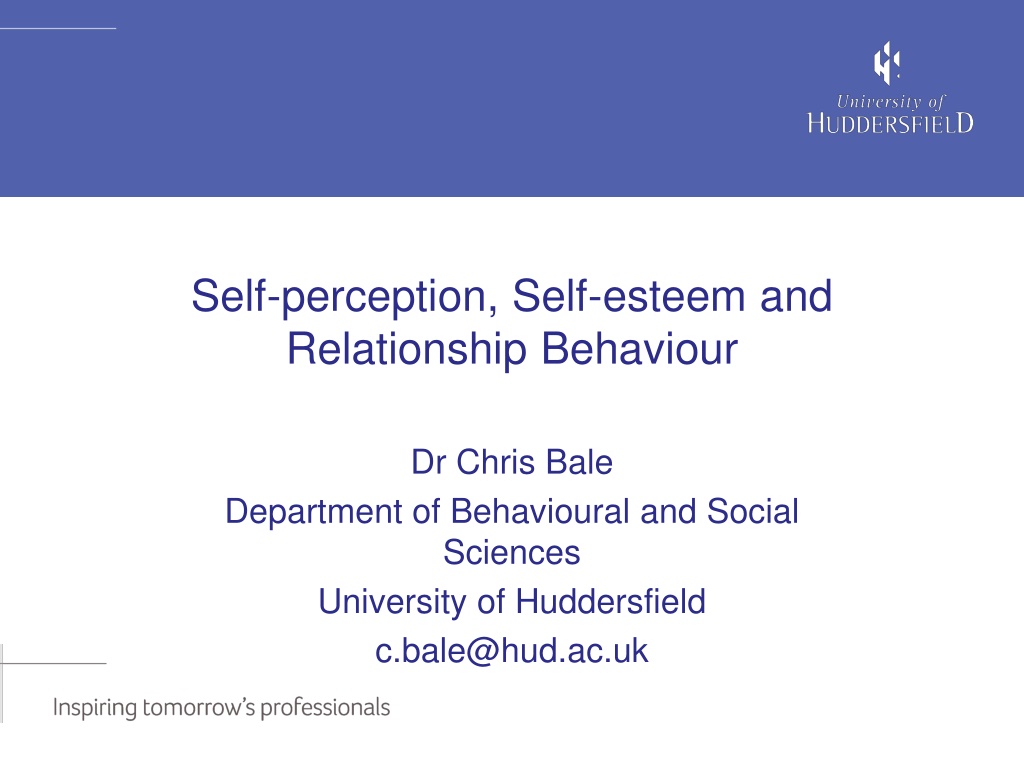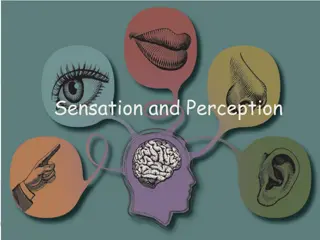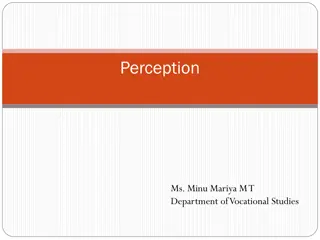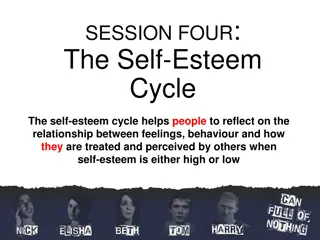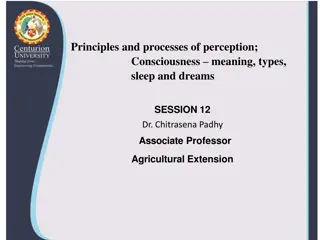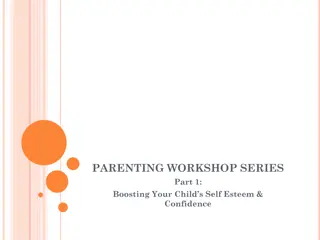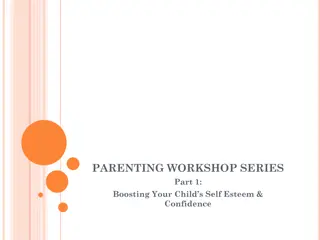Understanding Self-Perception, Self-Esteem, and Relationship Behavior
The discussion explores the impact of low self-esteem on various psychological issues, societal views on self-worth, self-perception biases, and the consequences of self-esteem in different aspects of life, backed by research and theories such as the Better-Than-Average Effect and Sociometer Theory.
Uploaded on Sep 28, 2024 | 0 Views
Download Presentation

Please find below an Image/Link to download the presentation.
The content on the website is provided AS IS for your information and personal use only. It may not be sold, licensed, or shared on other websites without obtaining consent from the author. Download presentation by click this link. If you encounter any issues during the download, it is possible that the publisher has removed the file from their server.
E N D
Presentation Transcript
Self-perception, Self-esteem and Relationship Behaviour Dr Chris Bale Department of Behavioural and Social Sciences University of Huddersfield c.bale@hud.ac.uk
The problem of low self-esteem Low self-esteem is the root of all of the problems in the world (Oprah Winfrey) I cannot think of a single psychological problem from anxiety and depression, to fear of intimacy or of success, to spouse battery or child molestation that is not traceable to the problem of low self- esteem (Dr Nathaniel Branden) Author of How to raise your self esteem ( 5.99) The epidemic of low self-esteem (Senator John Vasconcellos). Facebook users are insecure, narcissistic and have low self- esteem (Daily Mail, Sept 2010)
A quick experiment What percentage of people do you think you are more likeable than? Most likeable 0% 50% 100%
The better than average effect Most people think that they are above average on a wide range of positive traits, and below average on negative ones (e.g. Williams & Gilovich, 2008). E.g. intelligence, attractiveness, sense of humour, driving skill etc. This even applies to the effect itself! (Pronin, Gilovich, & Ross, 2004)
An epidemic of low self-esteem? Most people score above the mid point of self-esteem scales. Vast literature on positive biases in self-perception: Social comparisons Attributions and self serving bias Self-handicapping Memory Psychological benefits of self-deception E.g. optimism and self-fulfilling prophecies
Consequences of self esteem No clear relationships between self-esteem and adolescent smoking, drinking, drug abuse and sexual behaviour. Often high self-esteem is associated with aggression and prejudice. Problems of interpreting these relationships (i.e. direction of causation). E.g. Significant (but weak) relationships between self-esteem and academic performance (Baumeister et al. 2003). Top down vs Bottom up explanations of relationships between self-esteem and self-perceptions.
Sociometer Theory Leary & Baumeister (2000). Functional, evolutionary explanation of self- esteem. Self-esteem functions as an interpersonal monitor of: the quality and quantity of existing relationships, perceived eligibility for relationships, and motivates individuals to act accordingly.
Attractiveness and Self-esteem Self-perceived attractiveness (SPA) positively correlates with self-esteem in both sexes. (e.g. Nell & Ashton, 1996) Especially strong relationship in women. Correlational data is consistent with Sociometer theory ( bottom-up ). However data can also be explained by top-down theories (e.g. Brown et al. 2001) Studies showing that there is little relationship between self and other rated attractiveness (e.g. Diener et al, 1995) suggest against Sociometer theory. Need for experimental studies to examine direction of causation.
Does self-perceived attractiveness affect self-esteem? Female participants asked to rate attractiveness of (study 1; n = 128) or compare own attractiveness to (study 2; n = 137) hot or not pictures. Hot Not Then completed a variety of measures of SPA and SE.
Results No initial differences in SPA between groups. After the comparison task, participants in the Not condition rated themselves as significantly more attractive than those in the Hot group. No group differences on any self-esteem scales or subscales. Does SE affect SPA? (Study 3)
Study 3: Method 2 groups: +ve / -ve manipulation (Riketta & Dauenheimer, 2003) . 76 female participants asked to complete a reaction time test. + I BAD JKDWCBZV Fixation Prime (60 ms) Mask (60 ms) Respond: Left / Right Then complete SE manipulation check and a measure of SPA.
Results p<.05 p<.05 Participants in +ve condition reported significantly higher subsequent levels of both SE (d = .50) and SPA (d = .39).
Self-esteem and relational behaviour Sociometer theory predicts SE should affect relational behaviour. Limited and inconsistent evidence on this relationship (Baumeister et al, 2003). Dependency Regulation perspective (Murray et al, 2006) Individuals with low self-esteem are especially sensitive to rejection. They often react to this by denigrating and emotionally distancing themselves from their partners. How do individuals behave in the absence of relational threats?
Aims and predictions Study 4 examined relationships between women s: Self-esteem. Self-reported relational behaviour. Perceptions of their own and their partners relational desirability. Sociometer theory suggests low SE should predict more positive relational behaviour. Equity Theory (Thibaut & Kelly, 1959) suggests lower relative desirability should predict more positive behaviour.
Method 192 women aged 18-60 (mean = 27.2) engaged in long term relationships (> 3 months, mean = 5 years) completed online measures of: Self-esteem: SES (Rosenberg, 1965) & PEI (Shrauger & Schohn, 1995). Relational desirability: MVI (Kirsner et al, 2003) Self & Partner. Relational behaviour: MRI (Buss, 1988) & PSII (Ellis, 1998).
Results After controlling for age and length of relationship: Self esteem (SES) did not significantly predict relational behaviour. Relative desirability significantly negatively predicted partner investment behaviour (r2 = .27, p<.05). Women who feel less desirable than their partners invest more heavily in their relationships.
Conclusions Self-esteem seems to influence self-perceptions of attractiveness. No evidence that self-perceived attractiveness influences self-esteem: Implications for possible effects of media images on body image and self-esteem. Self-esteem does not seem to predict relational behaviour in women. What about men? Possible implications for understanding partner violence and abuse.
Summary It s unclear whether self-esteem affects behaviour. We should be cautious in interpreting correlational data on self-esteem. Most people are good at feeling good about themselves. This seems to contribute to happiness, health and wellbeing. Certain individuals (especially those who suffer from depression) are less able to do this. Beware of narcissistic and self-loathing facebook users!
Thanks for your attention Thanks for listening. Chris Bale c.bale@hud.ac.uk
